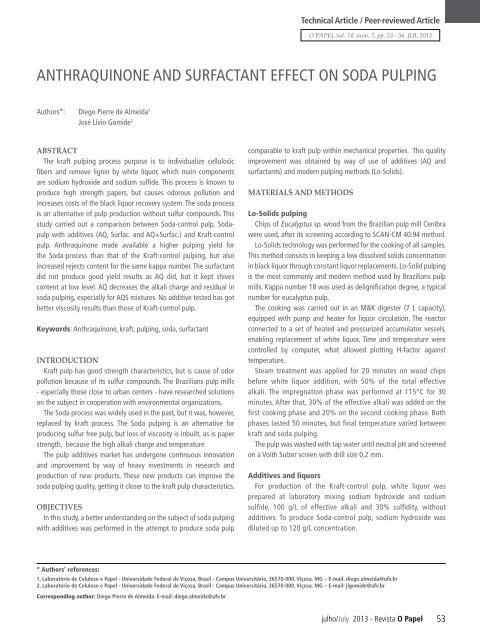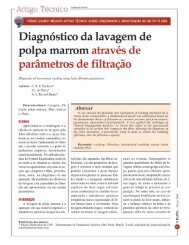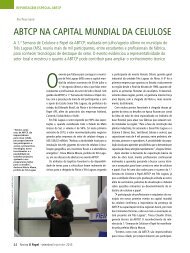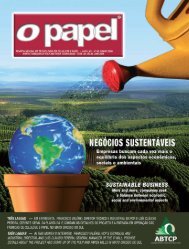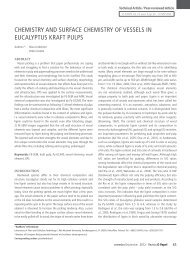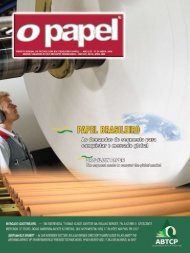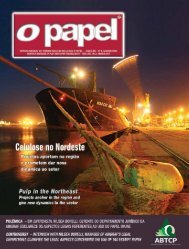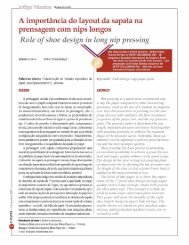anthraquinone and surfactant effect on soda pulping - Revista O Papel
anthraquinone and surfactant effect on soda pulping - Revista O Papel
anthraquinone and surfactant effect on soda pulping - Revista O Papel
Create successful ePaper yourself
Turn your PDF publications into a flip-book with our unique Google optimized e-Paper software.
Technical Article / Peer-reviewed Article<br />
O PAPEL vol. 74, num. 7, pp. 53 - 56 JUL 2013<br />
ANTHRAQUINONE AND SURFACTANT EFFECT ON SODA PULPING<br />
Authors*: Diego Pierre de Almeida 1<br />
José Lívio Gomide 2<br />
ABSTRACT<br />
The kraft <strong>pulping</strong> process purpose is to individualize cellulosic<br />
fibers <str<strong>on</strong>g>and</str<strong>on</strong>g> remove lignin by white liquor, which main comp<strong>on</strong>ents<br />
are sodium hydroxide <str<strong>on</strong>g>and</str<strong>on</strong>g> sodium sulfide. This process is known to<br />
produce high strength papers, but causes odorous polluti<strong>on</strong> <str<strong>on</strong>g>and</str<strong>on</strong>g><br />
increases costs of the black liquor recovery system. The <strong>soda</strong> process<br />
is an alternative of pulp producti<strong>on</strong> without sulfur compounds. This<br />
study carried out a comparis<strong>on</strong> between Soda-c<strong>on</strong>trol pulp, Sodapulp<br />
with additives (AQ, Surfac. <str<strong>on</strong>g>and</str<strong>on</strong>g> AQ+Surfac.) <str<strong>on</strong>g>and</str<strong>on</strong>g> Kraft-c<strong>on</strong>trol<br />
pulp. Anthraquin<strong>on</strong>e made available a higher <strong>pulping</strong> yield for<br />
the Soda-process than that of the Kraft-c<strong>on</strong>trol <strong>pulping</strong>, but also<br />
increased rejects c<strong>on</strong>tent for the same kappa number. The <str<strong>on</strong>g>surfactant</str<strong>on</strong>g><br />
did not produce good yield results as AQ did, but it kept shives<br />
c<strong>on</strong>tent at low level. AQ decreases the alkali charge <str<strong>on</strong>g>and</str<strong>on</strong>g> residual in<br />
<strong>soda</strong> <strong>pulping</strong>, especially for AQS mixtures. No additive tested has got<br />
better viscosity results than those of Kraft-c<strong>on</strong>trol pulp.<br />
Keywords: Anthraquin<strong>on</strong>e, kraft, <strong>pulping</strong>, <strong>soda</strong>, <str<strong>on</strong>g>surfactant</str<strong>on</strong>g><br />
INTRODUCTION<br />
Kraft pulp has good strength characteristics, but is cause of odor<br />
polluti<strong>on</strong> because of its sulfur compounds. The Brazilians pulp mills<br />
- especially those close to urban centers - have researched soluti<strong>on</strong>s<br />
<strong>on</strong> the subject in cooperati<strong>on</strong> with envir<strong>on</strong>mental organizati<strong>on</strong>s.<br />
The Soda process was widely used in the past, but it was, however,<br />
replaced by kraft process. The Soda <strong>pulping</strong> is an alternative for<br />
producing sulfur free pulp, but loss of viscosity is inbuilt, as is paper<br />
strength, because the high alkali charge <str<strong>on</strong>g>and</str<strong>on</strong>g> temperature.<br />
The pulp additives market has underg<strong>on</strong>e c<strong>on</strong>tinuous innovati<strong>on</strong><br />
<str<strong>on</strong>g>and</str<strong>on</strong>g> improvement by way of heavy investments in research <str<strong>on</strong>g>and</str<strong>on</strong>g><br />
producti<strong>on</strong> of new products. These new products can improve the<br />
<strong>soda</strong> <strong>pulping</strong> quality, getting it closer to the kraft pulp characteristics.<br />
OBJECTIVES<br />
In this study, a better underst<str<strong>on</strong>g>and</str<strong>on</strong>g>ing <strong>on</strong> the subject of <strong>soda</strong> <strong>pulping</strong><br />
with additives was performed in the attempt to produce <strong>soda</strong> pulp<br />
comparable to kraft pulp within mechanical properties. This quality<br />
improvement was obtained by way of use of additives (AQ <str<strong>on</strong>g>and</str<strong>on</strong>g><br />
<str<strong>on</strong>g>surfactant</str<strong>on</strong>g>s) <str<strong>on</strong>g>and</str<strong>on</strong>g> modern <strong>pulping</strong> methods (Lo-Solids).<br />
MATERIALS AND METHODS<br />
Lo-Solids <strong>pulping</strong><br />
Chips of Eucalyptus sp. wood from the Brazilian pulp mill Cenibra<br />
were used, after its screening according to SCAN-CM 40:94 method.<br />
Lo-Solids technology was performed for the cooking of all samples.<br />
This method c<strong>on</strong>sists in keeping a low dissolved solids c<strong>on</strong>centrati<strong>on</strong><br />
in black liquor through c<strong>on</strong>stant liquor replacements. Lo-Solid <strong>pulping</strong><br />
is the most comm<strong>on</strong>ly <str<strong>on</strong>g>and</str<strong>on</strong>g> modern method used by Brazilians pulp<br />
mills. Kappa number 18 was used as delignificati<strong>on</strong> degree, a typical<br />
number for eucalyptus pulp.<br />
The cooking was carried out in an M&K digester (7 L capacity),<br />
equipped with pump <str<strong>on</strong>g>and</str<strong>on</strong>g> heater for liquor circulati<strong>on</strong>. The reactor<br />
c<strong>on</strong>nected to a set of heated <str<strong>on</strong>g>and</str<strong>on</strong>g> pressurized accumulator vessels,<br />
enabling replacement of white liquor. Time <str<strong>on</strong>g>and</str<strong>on</strong>g> temperature were<br />
c<strong>on</strong>trolled by computer, what allowed plotting H-factor against<br />
temperature.<br />
Steam treatment was applied for 20 minutes <strong>on</strong> wood chips<br />
before white liquor additi<strong>on</strong>, with 50% of the total <str<strong>on</strong>g>effect</str<strong>on</strong>g>ive<br />
alkali. The impregnati<strong>on</strong> phase was performed at 115°C for 30<br />
minutes. After that, 30% of the <str<strong>on</strong>g>effect</str<strong>on</strong>g>ive alkali was added <strong>on</strong> the<br />
first cooking phase <str<strong>on</strong>g>and</str<strong>on</strong>g> 20% <strong>on</strong> the sec<strong>on</strong>d cooking phase. Both<br />
phases lasted 50 minutes, but final temperature varied between<br />
kraft <str<strong>on</strong>g>and</str<strong>on</strong>g> <strong>soda</strong> <strong>pulping</strong>.<br />
The pulp was washed with tap water until neutral pH <str<strong>on</strong>g>and</str<strong>on</strong>g> screened<br />
<strong>on</strong> a Voith Sulzer screen with drill size 0,2 mm.<br />
Additives <str<strong>on</strong>g>and</str<strong>on</strong>g> liquors<br />
For producti<strong>on</strong> of the Kraft-c<strong>on</strong>trol pulp, white liquor was<br />
prepared at laboratory mixing sodium hydroxide <str<strong>on</strong>g>and</str<strong>on</strong>g> sodium<br />
sulfide, 100 g/L of <str<strong>on</strong>g>effect</str<strong>on</strong>g>ive alkali <str<strong>on</strong>g>and</str<strong>on</strong>g> 30% sulfidity, without<br />
additives. To produce Soda-c<strong>on</strong>trol pulp, sodium hydroxide was<br />
diluted up to 120 g/L c<strong>on</strong>centrati<strong>on</strong>.<br />
* Authors’ references:<br />
1. Laboratório de Celulose e <strong>Papel</strong> - Universidade Federal de Viçosa, Brasil - Campus Universitário, 36570-000. Viçosa. MG – E-mail: diego.almeida@ufv.br<br />
2. Laboratório de Celulose e <strong>Papel</strong> - Universidade Federal de Viçosa, Brasil - Campus Universitário, 36570-000. Viçosa. MG – E-mail: jlgomide@ufv.br<br />
Corresp<strong>on</strong>ding author: Diego Pierre de Almeida. E-mail: diego.almeida@ufv.br<br />
julho/July 2013 - <strong>Revista</strong> O <strong>Papel</strong><br />
53
Technical Article / Peer-reviewed Article<br />
O PAPEL vol. 74, num. 7, pp. 53 - 56 JUL 2013<br />
Ashl<str<strong>on</strong>g>and</str<strong>on</strong>g> provided 3 additives to get better <strong>soda</strong> pulp<br />
properties: <str<strong>on</strong>g>anthraquin<strong>on</strong>e</str<strong>on</strong>g> (AQ), a mix of <str<strong>on</strong>g>surfactant</str<strong>on</strong>g>s (Surfac.)<br />
<str<strong>on</strong>g>and</str<strong>on</strong>g> a mix of <str<strong>on</strong>g>anthraquin<strong>on</strong>e</str<strong>on</strong>g> <str<strong>on</strong>g>and</str<strong>on</strong>g> <str<strong>on</strong>g>surfactant</str<strong>on</strong>g> (AQS).<br />
AQ dosages were 0,015%, 0,03%, 0,06%, 0,12%, 0,24%,<br />
0,36% <str<strong>on</strong>g>and</str<strong>on</strong>g> 0,48%. Surfac. dosages were 0,003%, 0,006%,<br />
0,012%, 0,024%, 0,06% <str<strong>on</strong>g>and</str<strong>on</strong>g> 0,12%. AQS dosages were 0,06%,<br />
0,12%, 0,24%, 0,36% <str<strong>on</strong>g>and</str<strong>on</strong>g> 0,48%. Pulping was performed in<br />
duplicate with 500 g oven dry wood chips.<br />
Pulp analysis<br />
Kappa number, screened yield (%), reject c<strong>on</strong>tent (%) <str<strong>on</strong>g>and</str<strong>on</strong>g><br />
viscosity (cm 3 /g) tests were performed <strong>on</strong> pulp, <str<strong>on</strong>g>and</str<strong>on</strong>g> <str<strong>on</strong>g>effect</str<strong>on</strong>g>ive<br />
residual alkali (g/L) was performed <strong>on</strong> black liquor.<br />
For screened yield <str<strong>on</strong>g>and</str<strong>on</strong>g> rejects c<strong>on</strong>tent, gravimetric method was<br />
used. Kappa number was determined by TAPPI T236 cm-85 method<br />
<str<strong>on</strong>g>and</str<strong>on</strong>g> viscosity by TAPPI T230 om-94 method. Using ISO 5351 method,<br />
the viscosity was c<strong>on</strong>verted to intrinsic viscosity. The black residual<br />
liquor was characterized by SCAN N-33:94 method.<br />
RESULTS<br />
C<strong>on</strong>trol pulp<br />
The <strong>pulping</strong> c<strong>on</strong>diti<strong>on</strong>s to produce the c<strong>on</strong>trols are given in Table 1.<br />
C<strong>on</strong>trol <strong>pulping</strong> results are given in Table 2. As expected,<br />
kraft c<strong>on</strong>trol showed the highest screened yield, with a 53.4%<br />
average. Intrinsic viscosity was 1231 cm³/g. The higher <str<strong>on</strong>g>effect</str<strong>on</strong>g>ive<br />
alkali charge <strong>on</strong> Soda-c<strong>on</strong>trol 1 decreased the screened yield<br />
to 47.5%. Soda-c<strong>on</strong>trol 2 showed 2% higher yield than Sodac<strong>on</strong>trol<br />
1, but its viscosity was 205 cm 3 /g lower. Probably,<br />
the higher alkaline charge damaged hemicelluloses harder,<br />
decreasing yield <str<strong>on</strong>g>and</str<strong>on</strong>g> increasing viscosity.<br />
Table 1. Pulping c<strong>on</strong>diti<strong>on</strong>s<br />
Pulping parameters Kraft-c<strong>on</strong>trol Soda-c<strong>on</strong>trol 1 Soda-c<strong>on</strong>trol 2<br />
Sulfidity 30% - -<br />
Effective alkali 100 g/L 120 g/L 120 g/L<br />
Liquor/wood ratio 4 4 4<br />
Steam 20 min 20 min 20 min<br />
Impregnati<strong>on</strong> temperature 115°C 115°C 115°C<br />
Impregnati<strong>on</strong> time 30 min 30 min 30 min<br />
Time to temperature 15 min 15 min 15 min<br />
Pulping temperature 155°C/160°C 155°C/160°C 172°C/172°C<br />
Pulping time 50 + 50 min 50 + 50 min 50 + 50 min<br />
Alkali charge rate 50%/30%/20% 50%/30%/20% 50%/30%/20%<br />
H-Factor 635 649 2070<br />
Table 2. C<strong>on</strong>trol <strong>pulping</strong> results<br />
Sample Rep. # H-Factor EA,%<br />
Kappa<br />
n.°<br />
Brightness<br />
%ISO<br />
Yield, %<br />
Screened Reject Total<br />
Visc. cm 3 /g<br />
EAR g/L<br />
1 635 20.0 18.1 - 53.5 0.1 53.6 1230 9.4<br />
Kraft-c<strong>on</strong>trol<br />
2 634 20.0 17.7 - 53.2 0.1 53.3 1233 8.6<br />
Avg 635 20.0 17.9 35.5 53.4 0.1 53.5 1231 9.0<br />
1 665 56.0 17.9 - 47.7 0.0 47.7 1062 42.4<br />
Soda-c<strong>on</strong>trol 1<br />
2 633 56.0 18.1 - 47.2 0.0 47.2 1072 42.4<br />
Avg 649 56.0 18.0 35.5 47.5 0.0 47.5 1067 42.4<br />
1 2072 25.0 18.3 - 49.7 0.1 49.8 871 11.8<br />
Soda-c<strong>on</strong>trol 2<br />
2 2068 25.0 17.9 - 49.2 0.1 49.3 853 13.3<br />
Avg 2070 25.0 18.1 33.4 49.5 0.1 49.6 862 12.6<br />
54 <strong>Revista</strong> O <strong>Papel</strong> - julho/July 2013
Technical Article / Peer-reviewed Article<br />
O PAPEL vol. 74, num. 7, pp. 53 - 56 JUL 2013<br />
Soda <strong>pulping</strong> with additives<br />
For comparis<strong>on</strong> purposes, <strong>on</strong> <strong>soda</strong> <strong>pulping</strong> with additives <strong>on</strong>ly<br />
Soda-c<strong>on</strong>trol 2 was used, which will be defined as Soda-c<strong>on</strong>trol <strong>on</strong>ly.<br />
Results were compared with Kraft-c<strong>on</strong>trol as well.<br />
Soda <strong>pulping</strong> with Anthraquin<strong>on</strong>e (Soda-AQ)<br />
Anthaquin<strong>on</strong>e was tested up to the limit of the yield growing.<br />
Results are given in Table 3.<br />
The yield for <strong>soda</strong> with 0.12% AQ dosage was higher than that<br />
for Kraft-c<strong>on</strong>trol, 0.3% higher. The highest yield was obtained for<br />
the 0.36% AQ dosage.<br />
Soda-AQ 0.36% could give until 5.2% higher screened yield in<br />
comparis<strong>on</strong> to the Soda-c<strong>on</strong>trol, <str<strong>on</strong>g>and</str<strong>on</strong>g> 1.3% higher compared to Kraftc<strong>on</strong>trol.<br />
As shown in Table 3, yield increases with the AQ dosage until<br />
0.36%, <str<strong>on</strong>g>and</str<strong>on</strong>g> decreases for the 0.48% dosage.<br />
The reject c<strong>on</strong>tent also increases with AQ dosage due to the<br />
alkaline charge reducti<strong>on</strong>. Soda-AQ 0.48% has used 2.5% less alkali<br />
than Kraft-c<strong>on</strong>trol. The <str<strong>on</strong>g>effect</str<strong>on</strong>g>ive residual alkali decreases with the<br />
alkaline charge, but holds acceptable levels for Lo-Solids <strong>pulping</strong>.<br />
The AQ additi<strong>on</strong> improves viscosity, but not enough to exceed the<br />
Kraft-c<strong>on</strong>trol viscosity.<br />
Soda <strong>pulping</strong> with <str<strong>on</strong>g>surfactant</str<strong>on</strong>g> (Surfac.)<br />
The average results for <str<strong>on</strong>g>surfactant</str<strong>on</strong>g> <strong>pulping</strong> are given in Table 4.<br />
The <str<strong>on</strong>g>surfactant</str<strong>on</strong>g> additi<strong>on</strong> gave a minor screened yield gain compared<br />
with Soda-c<strong>on</strong>trol, 2.1% more. But it was not enough for<br />
performing better than the Kraft-c<strong>on</strong>trol. The alkaline charge for<br />
Soda-Surfac. 0.12% was 1% lower compared to Soda-c<strong>on</strong>trol. A<br />
decrease from 25% to 24%.<br />
The viscosity increased when compared to Soda-c<strong>on</strong>trol, but<br />
not showing any relati<strong>on</strong> with the <str<strong>on</strong>g>surfactant</str<strong>on</strong>g> dosage. The reject<br />
c<strong>on</strong>tent kept c<strong>on</strong>stant.<br />
Table 3. Soda-<str<strong>on</strong>g>anthraquin<strong>on</strong>e</str<strong>on</strong>g> <strong>pulping</strong> results<br />
Sample H-Factor EA,% Kappa<br />
Brightness,<br />
%ISO<br />
Yield, %<br />
Screened Reject Total<br />
Visc. cm 3 /g<br />
EAR g/L<br />
Kraft-c<strong>on</strong>trol 635 20.0 17.9 35.5 53.4 0.1 53.5 1231 9.0<br />
Soda-c<strong>on</strong>trol 2070 25.0 18.1 33.4 49.5 0.1 49.6 862 12.6<br />
Soda-AQ 0.015% 2064 22.5 18.2 32.5 50.2 0.1 50.2 967 9.2<br />
Soda-AQ 0.03% 2011 21.5 18.2 30.2 52.1 0.2 52.2 953 7.7<br />
Soda-AQ 0.06% 2028 20.5 18.0 31.2 52.7 0.2 52.9 1026 6.9<br />
Soda-AQ 0.12% 2088 19.0 17.9 29.8 53.7 0.3 54.0 1023 4.9<br />
Soda-AQ 0.24% 2053 18.3 18.5 28.9 54.5 0.5 55.0 1039 3.5<br />
Soda-AQ 0.36% 2037 18.3 17.9 29.1 54.7 0.3 55.0 1034 3.8<br />
Soda-AQ 0.48% 2032 17.5 17.9 29.7 53.7 0.4 54.0 1005 4.7<br />
Table 4. Soda-Surfac. <strong>pulping</strong> results<br />
Sample H-Factor EA,% Kappa<br />
Brightness,<br />
%ISO<br />
Yield, %<br />
Screened Reject Total<br />
Visc. cm 3 /g<br />
EAR<br />
g/L<br />
Kraft-c<strong>on</strong>trol 635 20.0 17.9 35.5 53.4 0.1 53.5 1231 9.0<br />
Soda-c<strong>on</strong>trol 2070 25.0 18.1 33.4 49.5 0.1 49.6 862 12.6<br />
Soda-Surfac. 0.003% 2011 25.0 18.5 35.0 49.0 0.1 49.1 935 12.5<br />
Soda-Surfac. 0.006% 2041 25.0 18.0 33.8 49.8 0.1 49.8 913 13.2<br />
Soda-Surfac. 0.012% 2003 25.0 17.8 35.0 50.3 0.1 50.3 902 11.2<br />
Soda-Surfac. 0.024% 2094 24.0 17.9 33.4 50.8 0.1 50.9 902 10.7<br />
Soda-Surfac. 0.060% 2031 24.0 18.1 34.9 51.6 0.0 51.6 897 10.5<br />
Soda-Surfac. 0.120% 1988 24.0 18.3 34.1 49.9 0.0 49.9 919 11.4<br />
julho/July 2013 - <strong>Revista</strong> O <strong>Papel</strong><br />
55
Technical Article / Peer-reviewed Article<br />
O PAPEL vol. 74, num. 7, pp. 53 - 56 JUL 2013<br />
Table 5. Soda-AQS <strong>pulping</strong> results<br />
Sample H-Factor EA,% Kappa<br />
Brightness<br />
%ISO<br />
Yield, %<br />
Screened Reject Total<br />
Visc. cm 3 /g<br />
EAR<br />
g/L<br />
Kraft-c<strong>on</strong>trol 635 20.0 17.9 35.5 53.4 0.1 53.5 1231 9.0<br />
Soda-c<strong>on</strong>trol 2070 25.0 18.1 33.4 49.5 0.1 49.6 862 12.6<br />
Soda-AQS 0.06% 2022 21.5 18.1 31.5 52.4 0.2 52.6 1005 7.1<br />
Soda-AQS 0.12% 2040 20.5 18.2 32.1 52.4 0.4 52.8 996 6.4<br />
Soda-AQS 0.24% 2013 19.5 17.5 28.9 53.9 0.2 54.1 1031 3.4<br />
Soda-AQS 0.36% 2050 19.0 18.5 28.1 54.0 0.4 54.4 1077 3.8<br />
Soda-AQS 0.48% - 18.5 18.5 28.4 54.2 0.4 54.6 1050 3.8<br />
Soda <strong>pulping</strong> with <str<strong>on</strong>g>anthraquin<strong>on</strong>e</str<strong>on</strong>g> <str<strong>on</strong>g>and</str<strong>on</strong>g> <str<strong>on</strong>g>surfactant</str<strong>on</strong>g> (AQS)<br />
The <str<strong>on</strong>g>surfactant</str<strong>on</strong>g> promotes a dispersant acti<strong>on</strong> <str<strong>on</strong>g>and</str<strong>on</strong>g> also<br />
increases wood chips impregnati<strong>on</strong>, thereby complementing<br />
the <str<strong>on</strong>g>anthraquin<strong>on</strong>e</str<strong>on</strong>g> chemistry acti<strong>on</strong> in protecting carbohydrates<br />
<str<strong>on</strong>g>and</str<strong>on</strong>g> in lignin reducti<strong>on</strong>. Results for Soda-AQS <strong>pulping</strong> are given<br />
in Table 5.<br />
The highest yield was obtained with the 0.48% AQS dosage,<br />
0.8% more than Kraft-c<strong>on</strong>trol. The <str<strong>on</strong>g>surfactant</str<strong>on</strong>g> c<strong>on</strong>tent <strong>on</strong> AQS<br />
mix was not enough to avoid rejects. As shown in Table 5, the<br />
higher dosage produced 0.4% rejects c<strong>on</strong>tent.<br />
The alkaline charge <str<strong>on</strong>g>and</str<strong>on</strong>g> <str<strong>on</strong>g>effect</str<strong>on</strong>g>ive alkali residual decreased<br />
with the increasing of the AQS dosage. The Soda-AQS 0.48%<br />
alkali pulp was 1.5% lower than the Kraft-c<strong>on</strong>trol pulp. The<br />
higher viscosity was 1077 cm 3 /g for Soda-AQS 0.36%, but<br />
lower than that of the Kraft-c<strong>on</strong>trol.<br />
screened yield level <str<strong>on</strong>g>and</str<strong>on</strong>g>, for some dosages, this yield turns<br />
out higher than that of the Kraft-c<strong>on</strong>trol yield. However, reject<br />
c<strong>on</strong>tent increases for same kappa number. The same came<br />
about with the AQS mix pulp.<br />
Surfactant additi<strong>on</strong> did not show good results for screened<br />
yield, but kept a low reject c<strong>on</strong>tent. The <str<strong>on</strong>g>surfactant</str<strong>on</strong>g> dosage<br />
for the AQS mix pulp can be increased if aimed at c<strong>on</strong>verting<br />
rejects in screened yield.<br />
Some <str<strong>on</strong>g>anthraquin<strong>on</strong>e</str<strong>on</strong>g> dosages decrease a lot the alkali<br />
charge <str<strong>on</strong>g>and</str<strong>on</strong>g> <str<strong>on</strong>g>effect</str<strong>on</strong>g>ive alkali residual, mainly for AQS <strong>pulping</strong>.<br />
So, it is possible to reduce the H-factor when the AQ dosage is<br />
increased, thereafter making the viscosity higher.<br />
Any additive could produce Soda-pulp with a higher viscosity<br />
than that of the Kraft-c<strong>on</strong>trol pulp.<br />
CONCLUSIONS<br />
The <str<strong>on</strong>g>anthraquin<strong>on</strong>e</str<strong>on</strong>g> additi<strong>on</strong> increases the <strong>soda</strong> <strong>pulping</strong><br />
Acknowledgments<br />
I wish to express my gratitude to Cenibra <str<strong>on</strong>g>and</str<strong>on</strong>g> Ashl<str<strong>on</strong>g>and</str<strong>on</strong>g> for<br />
providing the material used in this study, to the Pulp <str<strong>on</strong>g>and</str<strong>on</strong>g> Paper<br />
Laboratory/UFV <str<strong>on</strong>g>and</str<strong>on</strong>g> to CNPq.<br />
•<br />
REFERENCES<br />
1. CARNEIRO, A. M. O. Modificações do processo kraft c<strong>on</strong>venci<strong>on</strong>al para deslignificação intensiva da madeira de eucalipto. 1992. 77 f. Dissertação<br />
(Mestrado em Ciência Florestal) – Universidade Federal de Viçosa, Viçosa, 1992.<br />
2. FISEROVÁ, M., LUZAKOVÁ, V. Aplicação de <str<strong>on</strong>g>surfactant</str<strong>on</strong>g>es como aditivos na polpação kraft. O <strong>Papel</strong>, São Paulo, p. 96 – 103, novembro, 2000.<br />
3. GOMIDE, J.L. Antraquin<strong>on</strong>a – um eficiente aditivo para a polpação alcalina de madeiras. Viçosa. SIF, 1980. 27p. (Bol. Técnico nº6). O <strong>Papel</strong>, São<br />
Paulo, p. 39-48, outubro, 1980a.<br />
4. GOMIDE, J.L., OLIVEIRA, R.C., COLODETTE, J.L. Produção de polpa kraft de eucalipto, com adição de antraquin<strong>on</strong>a. <strong>Revista</strong> Árvore, Viçosa,<br />
v.4, n.2. p.203 – 214, 1980b.<br />
5. HARTLER, N. Extended delignificati<strong>on</strong> in kraft cooking – a new c<strong>on</strong>cept. Svensk Papperstinding, v. 81, n. 15, p. 483-484, 1978.<br />
56 <strong>Revista</strong> O <strong>Papel</strong> - julho/July 2013


